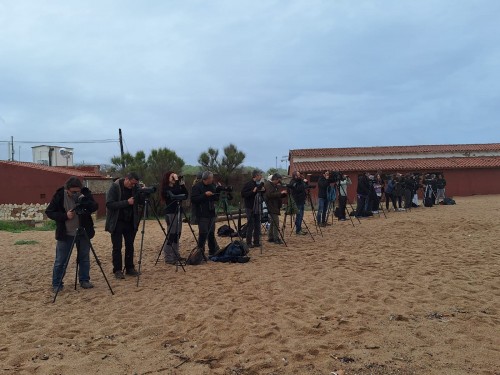
Isabel Moreno: "L'acció climàtica és una cursa de fons i aturar-se no és una opció"
Isabel Moreno: "L'acció climàtica és una cursa de fons i aturar-se no és una opció"



Isabel Moreno: "L'acció climàtica és una cursa de fons i aturar-se no és una opció"
Xerrem amb la divulgadora, presentadora, meteoròloga i experta en canvi climàtic sobre el moment en què ens trobem i la necessitat d’actuar amb urgència per revertir l’emergència que patim.
“Si només entenem el canvi climàtic des d’un punt de vista científic, no estarem entenent en absolut el canvi climàtic”, exposava la Isabel Moreno per començar la seva intervenció en la jornada de Resiliència climàtica urbana, celebrada com a esdeveniment final dels projectes Cooltorise, organitzat per entitats com l’Associació Benestar i Desenvolupament (ABD) i Ecoserveis, entre altres, i enfocat a resoldre la pobresa energètica d’estiu, i Climate Pact.
Todo preparado para el #FES2024 con #ClimatePact @COOLtoRISE
— ABD (@abd_ong) April 26, 2024
Jornada sobre resiliencia climática urbana donde reflexionaremos sobre cómo se adaptan las ciudades al verano pic.twitter.com/Cho3klYSAb
Aprofitem l’avinentesa per xerrar amb la divulgadora, meteoròloga, presentadora de televisió i experta en canvi climàtic, entre altres, sobre la urgència d’actuar, l’augment de fenòmens extrems lligats a la crisi climàtica, els canvis que cal abordar i les resistències amb què topa l’acció climàtica, entre moltes altres coses.
Hem d’esperar més fenòmens extrems, com sequeres, danes i onades de calor arran del canvi climàtic?
Cal separar les coses. Hi ha fenòmens que sí que sabem que aniran a pitjor o, en el millor dels escenaris, continuaran de manera similar a com fins ara, com poden ser les onades de calor. Ara bé, en altres, com el tema de les precipitacions o les danes, la resposta és més complexa i queden moltes preguntes per resoldre. Pel que fa a les sequeres, ara mateix les projeccions ens diuen que la regió mediterrània té molts números per acabar sent una sucursal del Sàhara. Sabem que Espanya és un país més aviat sec, i el més probable és que vagi a més.
Aquesta incertesa sobre moltes coses no ajuda a comunicar i divulgar sobre el canvi climàtic, com és el teu cas.
És veritat que hi ha aspectes en què hi ha molta incertesa, però això no vol dir que no sapiguem el que passarà. No podem saber si en el futur hi haurà més danes o no, per exemple, però sí que podem saber que si ve un sistema que provoqui pluges, amb una atmosfera més càlida i un mar Mediterrani ardent, afavorirà qles pluges siguin més potents i intenses.
Estem donant respostes a la crisi climàtica a l’alçada de l’emergència que patim?
Per descomptat que no. El canvi climàtic és un dels principals reptes que enfrontem com a humanitat i necessita, d’entrada, que tots remem en la mateixa direcció. I no valen excuses ni comparacions, cal actuar de forma global. Amb tot, la situació en què estem ja no només depèn de les emissions que generem actualment, sinó de les que ja hem generat fins ara. Per tant, la tendència és molt difícil de revertir a escala humana.
Els canvis que cal abordar són profunds.
Exacte, no es tracta només de substituir una substància per una altra, com ha passat, per exemple, amb la destrucció de la capa d’ozó. En aquest cas, sabíem que hi havia una sèrie de substàncies que danyaven l’ozó estratosfèric. Es van prohibir i avui el problema s’ha reduït i la capa d’ozó s’està recuperant. Amb el canvi climàtic no funciona així. Inclús si fem una transició energètica, calen altres canvis, i no només en l’àmbit de la ciència, també han de ser canvis socials, econòmics, en el consum…
"Cal passar a l’acció ja perquè cada pas que fem és un pas que no podrem retrocedir."
Manca consciència entre la població pel que fa a aquest canvi d’hàbits, per exemple en el que mengem o en la necessitat de reduir l’ús del cotxe?
Em fa gràcia perquè ara es parla molt dels canvis necessaris en l’àmbit de l’alimentació i de seguida pensem en el ‘chuletón’, però es parla molt poc del malbaratament alimentari. I estem malbaratant prop del 30% dels aliments que es produeixen. Imagina el recorregut de millora que tenim en aquest sentit.
Per tant, cal continuar fent molta pedagogia.
Sí, perquè cal molta més consciència, però, amb tot, crec que estem en un bon punt de partida. Ho demostra que ara mateix estem parlant d’això i és un tema que està sobre la taula.
I cada cop tenim més informació sobre el canvi climàtic
Sí, però penso que tampoc ens cal tenir absolutament tota la informació per actuar. Et poso un exemple: al cotxe, ens posem el cinturó de seguretat perquè sabem que un accident pot tenir conseqüències greus, però no necessitem saber exactament que si tenim un xoc a 50 km/h ens trencarem una costella o ens la fracturarem. No ho sabem, però ens posem el cinturó davant el que pugui passar. Doncs amb el canvi climàtic passa una mica el mateix, sabem que hem d’escometre canvis. I és veritat que hi ha entitats que tenen més responsabilitat i rang d’acció per actuar, però si la ciutadania no suma, no aconseguirem res.
Què en penses de la teoria que diu que la tecnologia ens salvarà de tot, també de la crisi climàtica?
No crec en el tecnooptimisme, de fet, les tecnologies que tenim actualment no estan a l’altura del repte que tenim al davant. Igualment, no podem confiar en una cosa que no sabem si arribarà. Jo ho explico amb la metàfora de la partida de cartes. És a dir, estem jugant una partida que tenim difícil guanyar, però si juguem les cartes que tenim amb estratègia i intel·ligència, potser no guanyarem, però podem quedar en bona posició o no perdre. El tecnooptimisme és esperar un as que potser mai arriba, o arriba massa tard. No podem confiar en això i hem d’actuar urgentment.
Ets partidària de fixar dates límit, com el 2030 o el 2050?
A mi no m’agrada utilitzar aquesta mena de dates perquè, al final, pots transmetre la percepció que no cal que actuem amb tanta urgència. Això no és com un examen, en què estudies el dia abans i pots aprovar. No podem afrontar aquest repte d’aquesta manera. Cal passar a l’acció ja perquè cada pas que fem és un pas que no podrem retrocedir.
A més, si arribem a aquestes dates i no hem assolit els objectius fixats, pot existir la temptació de tirar la tovallola, i aquest no és el camí. L’acció climàtica és una cursa de fons i aturar-se no és una opció. Hem de continuar lluitant per un futur millor, perquè encara és possible aconseguir-ho.
Malgrat totes les evidències, ha sorgit amb força un negacionisme climàtic que fa molt de soroll.
Aquest sector és minoritari, però és veritat que fa molt de soroll perquè compta amb altaveus potents, sobretot a les xarxes socials. I actua de manera de molt agressiva. De fet, les persones que ens dediquem a divulgar sobre el canvi climàtic sovint som víctimes d’insults i amenaces, i això és intolerable. Cal confrontar aquest discurs i les seves derivades.
Com quines?
Ara, per exemple, el que més protagonisme té és l’anomenat retardisme, una postura que busca diferents excuses per no fer res o retardar l’acció climàtica. No podem comprar discursos que advoquen per aturar-se per qüestions econòmiques, d’interessos o altres.
Per acabar, quin missatge voldries llançar?
Un missatge d’esperança i de crida a l’acció climàtica. Hem de fer tot el que està en les nostres mans com a ciutadans. I parlo de ciutadania perquè és qui llegirà aquesta entrevista. És evident que si fes una xerrada en una empresa o una institució, el missatge seria diferent, però ara parlo per a la ciutadania. Tots plegats hem de contribuir al canvi i pensar que tenim marge per canviar les coses. I, sobretot, utilitzar el poder que tenim com a ciutadania per exigir accions immediates.
Projecte ForestLab a l'Estació Biològica del Montseny
 Aquest mes d'abril s'ha tornat a iniciar el Projecte ForestLab de l’Estació Biològica del Montseny. L'objectiu principal d'aquest projecte és entendre la fenologia de la cria dels ocells i la seva biologia reproductiva, això demana entendre si hi ha algun factor que influeixi en la ubicació escollida per als nius, l'inici de la reproducció, la mida de la posta (nombre d’ous que han post), el temps d'incubació, etc. Les cinc espècies focals del projecte són el pica-soques blau (Sitta europaea) i quatre espècies de mallerengues: mallerenga carbonera (Parus major), mallerenga blava (Cyanistes caeruleus), mallerenga petita (Periparus ater) i mallerenga emplomallada (Lophophanes cristatus). En total hi ha 176 caixes niu repartides pel Montseny en 6 tipus d'hàbitats diferents. Aquests hàbitats es divideixen en 3 tipus de bosc: bosc caducifoli, que està format per faigs, roures o castanyers; bosc de coníferes, que inclou avets i pins i, finalment, bosc d'esclerofil·les, format per alzines o oliveres. També es divideixen en 3 tipus diferents d'altures: alta, si el bosc es troba a 1600 m sobre el nivell del mar; mitjana, si està al voltant de 900 m sobre el nivell del mar i baixa, si està al voltant de 250 m sobre el nivell del mar.
Aquest mes d'abril s'ha tornat a iniciar el Projecte ForestLab de l’Estació Biològica del Montseny. L'objectiu principal d'aquest projecte és entendre la fenologia de la cria dels ocells i la seva biologia reproductiva, això demana entendre si hi ha algun factor que influeixi en la ubicació escollida per als nius, l'inici de la reproducció, la mida de la posta (nombre d’ous que han post), el temps d'incubació, etc. Les cinc espècies focals del projecte són el pica-soques blau (Sitta europaea) i quatre espècies de mallerengues: mallerenga carbonera (Parus major), mallerenga blava (Cyanistes caeruleus), mallerenga petita (Periparus ater) i mallerenga emplomallada (Lophophanes cristatus). En total hi ha 176 caixes niu repartides pel Montseny en 6 tipus d'hàbitats diferents. Aquests hàbitats es divideixen en 3 tipus de bosc: bosc caducifoli, que està format per faigs, roures o castanyers; bosc de coníferes, que inclou avets i pins i, finalment, bosc d'esclerofil·les, format per alzines o oliveres. També es divideixen en 3 tipus diferents d'altures: alta, si el bosc es troba a 1600 m sobre el nivell del mar; mitjana, si està al voltant de 900 m sobre el nivell del mar i baixa, si està al voltant de 250 m sobre el nivell del mar.Aquestes caixes seran controlades regularment durant els propers mesos. En funció de si es troba o no material de niu en aquestes visites, les caixes es poden considerar:
1) buides, si no hi ha material present;
2) mica, si hi ha una mica de molsa o un altre material de niu;
3) fons, si la major part del fons està ple de material de niu;
4) tassa, si el material del niu mostra una forma de copa a la part superior;
5) folre, si hi ha material de revestiment a l'interior, com plomes d’altres ocells o pels de mamífers.
Si es troba material de niu dins de les caixes, es revisarà un cop a la setmana fins que es trobin els ous i un cop iniciat el procés d'incubació, es revisarà la caixa en dues setmanes per trobar el dia d'eclosió dels pollets. Es registraran dades com quan es va pondre el primer ou, quants ous es van pondre, els temps d'incubació, quants ous van eclosionar, etc. També es registrarà el resultat dels nius i els pollets, és a dir, si va tenir èxit, i els pollets van sobreviure i van volar del niu, o si va fallar i els nius van ser depredats o abandonats.
Per a aquest any, gràcies a la Patricia Teixera, una estudiant en pràctiques de la universitat d’Aveiro (Portugal) que recentment s’ha unit a l’equip de Fontmartina, s'ha afegit un nou objectiu a aquest projecte: construir una clau d'identificació d'edat per a les quatre espècies de mallerengues. Un cop eclosionen els ous, els pollets seran visitats cada dia, si la meteorologia ho permet, per tal de poder-los fer fotos. Les fotos es faran des de dos angles diferents, un des de dalt i un altre de lateral, de manera que en un futur sigui possible identificar la seva edat a través del seu desenvolupament, com ara, el creixement dels raquis de les plomes primàries, quan aquests raquis treuen barbes i quan comencen a obrir els ulls. A més, cada vegada que es manipulin els pollets per a les fotos, també es registrarà el seu pes. Aquesta clau d’identificació d’edat ajudarà al projecte PARUS, un nou projecte de l’ICO enfocat als anelladors científics que treballen amb caixes niu o pollets que encara estan al niu.
Des de l'inici del projecte, hem tingut un total de 63 caixes ocupades, de les quals 22 tenen ous, 20 tenen pollets i a 21 d’elles, els pollets ja han envolat. Les espècies més comunes que es troben són la mallerenga blava, amb 15 nius i la mallerenga carbonera amb 12 nius, seguides per la mallerenga petita, amb 9 nius, del pica-soques blau amb 6 nius, la mallerenga emplomallada, amb 3 nius i amb només 2 nius confirmats tenim el raspinell.
Podeu seguir els resultats d'aquest projecte al web: Nius.cat i a les xarxes socials de l’estació biològica del Montseny (@EBMontseny_ICO).
Trobada de col·laboradors/es del projecte SAM
 El SAM (Seguiment d’Aus Marines) va néixer el passat febrer amb l’objectiu de recollir informació i ampliar coneixement sobre un dels grups menys monitoritzats de Catalunya, els ocells marins. El format dels censos té un disseny molt lliure, qualsevol persona amb telescopi i coneixements d’identificació d’ocells marins pot anar el dia que vulgui i les vegades que vulgui a qualsevol dels 6 punts de cens. Ara bé, cada primer dissabte de cada mes, tots els col·laboradors/es amb disponibilitat per aquell dia, es troben en el seu punt de cens de referència per fer un cens simultani de tots els 6 punts.
El SAM (Seguiment d’Aus Marines) va néixer el passat febrer amb l’objectiu de recollir informació i ampliar coneixement sobre un dels grups menys monitoritzats de Catalunya, els ocells marins. El format dels censos té un disseny molt lliure, qualsevol persona amb telescopi i coneixements d’identificació d’ocells marins pot anar el dia que vulgui i les vegades que vulgui a qualsevol dels 6 punts de cens. Ara bé, cada primer dissabte de cada mes, tots els col·laboradors/es amb disponibilitat per aquell dia, es troben en el seu punt de cens de referència per fer un cens simultani de tots els 6 punts.
Des de bon inici, el projecte ha tingut molt bona rebuda per part de les persones observadores del mar a Catalunya, que hem volgut recompensar. És per això, que el passat 24 d’abril vam celebrar una trobada de col·laboradors i col·laboradores amb l’ajuda de NatMont, l’associació coordinadora del punt de cens del delta de la Tordera. La jornada va començar amb un taller teòric d’identificació d’ocells marins de la mà de l’Oriol Clarabuch, on es van repassar trucs i tècniques d’identificació d’ocells marins des de la costa. En acabat, coincidint que va deixar de ploure, es va dur a terme un cens amb metodologia SAM al delta de la Tordera. El comptatge es va tancar amb un registre altament divers, en el qual vam poder veure paràsit cuaample (Stercorarius pomarinus), paràsit cuapunxegut (Stercorarius parasiticus), ocell de tempesta (Hydrobates pelagicus), entre molts altres.
Finalment, es va tancar el dia amb un sopar de germanor per celebrar l’èxit de la jornada. Si tens ganes de convertir-te en col·laborar/a del SAM, ja sigui fent censos pel teu compte o assistint als censos del primer dissabte de mes, omple aquest formulari https://acortar.link/9ZghuP.
Per a més informació, visita la pàgina web del projecte https://ornitologia.org/ca/quefem/monitoratge/seguiment/sam/index.html o posa’t en contacte amb la coordinació marc.fusellas@ornitologia.org
Trobadas col·laboradors/es del projecte SAM
 El SAM (Seguiment d’Aus Marines) va néixer el passat febrer amb l’objectiu de recollir informació i ampliar coneixement sobre un dels grups menys monitoritzats de Catalunya, els ocells marins. El format dels censos té un disseny molt lliure, qualsevol persona amb telescopi i coneixements d’identificació d’ocells marins pot anar el dia que vulgui i les vegades que vulgui a qualsevol dels 6 punts de cens. Ara bé, cada primer dissabte de cada mes, tots els col·laboradors/es amb disponibilitat per aquell dia, es troben en el seu punt de cens de referència per fer un cens simultani de tots els 6 punts.
El SAM (Seguiment d’Aus Marines) va néixer el passat febrer amb l’objectiu de recollir informació i ampliar coneixement sobre un dels grups menys monitoritzats de Catalunya, els ocells marins. El format dels censos té un disseny molt lliure, qualsevol persona amb telescopi i coneixements d’identificació d’ocells marins pot anar el dia que vulgui i les vegades que vulgui a qualsevol dels 6 punts de cens. Ara bé, cada primer dissabte de cada mes, tots els col·laboradors/es amb disponibilitat per aquell dia, es troben en el seu punt de cens de referència per fer un cens simultani de tots els 6 punts.
Des de bon inici, el projecte ha tingut molt bona rebuda per part de les persones observadores del mar a Catalunya, que hem volgut recompensar. És per això, que el passat 24 d’abril vam celebrar una trobada de col·laboradors i col·laboradores amb l’ajuda de NatMont, l’associació coordinadora del punt de cens del delta de la Tordera. La jornada va començar amb un taller teòric d’identificació d’ocells marins de la mà de l’Oriol Clarabuch, on es van repassar trucs i tècniques d’identificació d’ocells marins des de la costa. En acabat, coincidint que va deixar de ploure, es va dur a terme un cens amb metodologia SAM al delta de la Tordera. El comptatge es va tancar amb un registre altament divers, en el qual vam poder veure paràsit cuaample (Stercorarius pomarinus), paràsit cuapunxegut (Stercorarius parasiticus), ocell de tempesta (Hydrobates pelagicus), entre molts altres.
Finalment, es va tancar el dia amb un sopar de germanor per celebrar l’èxit de la jornada. Si tens ganes de convertir-te en col·laborar/a del SAM, ja sigui fent censos pel teu compte o assistint als censos del primer dissabte de mes, omple aquest formulari https://acortar.link/9ZghuP.
Per a més informació, visita la pàgina web del projecte https://ornitologia.org/ca/quefem/monitoratge/seguiment/sam/index.html o posa’t en contacte amb la coordinació marc.fusellas@ornitologia.org
DISSABTE 1/6 CANCEL·LADA SORTIDA D'OBSERVACIÓ A PUJALT
DISSABTE 1/6 CANCEL·LADA SORTIDA D´OBSERVACIÓ A PUJALT
Us informem que degut a les condicions meteorològiques adverses, la sortida d´observació a Pujalt ha estat CANCEL·LADA.






